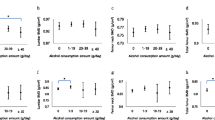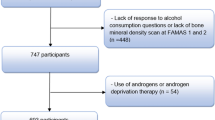Abstract
Background
Alcohol is calorie dense, and impacts activity, appetite and lipid processing. The aim of this study was to therefore investigate the association between alcohol consumption and components of body composition including bone, fat and lean tissue.
Methods
Participants were recruited from a randomly selected, population-based sample of 534 men aged 65 years and older enrolled in the Geelong Osteoporosis Study. Alcohol intake was ascertained using a food frequency questionnaire and the sample categorised as non-drinkers or alcohol users who consumed ≤2, 3–4 or ≥5 standard drinks on a usual drinking day. Bone mineral density (BMD), lean body mass and body fat mass were measured using dual energy X-ray absorptiometry; overall adiposity (%body fat), central adiposity (%truncal fat) and body mass index (BMI) were calculated. Bone quality was determined by quantitative heel ultrasound (QUS).
Results
There were 90 current non-drinkers (16.9 %), 266 (49.8 %) consumed 1–2 drinks/day, 104 (19.5 %) 3–4 drinks/day and 74 (13.8 %) ≥5 drinks/day. Those consuming ≥5 drinks/day had greater BMI (+4.8 %), fat mass index (+20.1 %), waist circumference (+5.0 %), %body fat (+15.2 %) and proportion of trunk fat (+5.3 %) and lower lean mass (−5.0 %) than non-drinkers after adjustment for demographic and lifestyle factors. Furthermore, they were more likely to be obese than non-drinkers according to criteria based on BMI (OR = 2.83, 95 %CI 1.10–7.29) or waist circumference (OR = 3.36, 95 %CI 1.32–8.54). There was an inverse relationship between alcohol consumption and QUS parameters and BMD at the mid forearm site; no differences were detected for BMD at other skeletal sites.
Conclusion
Higher alcohol intake was associated with greater total and central adiposity and reduced bone quality.


Similar content being viewed by others
References
AIHW. Australian Institute of Health and Welfare (2011) 2010 National Drug Strategy Household Survey report. Drug statistics series no. 25. Cat. no. PHE 145. AIHW, Canberra. Contract No.: Document Number
McLennan W, Podger A (1998) National Nutrition Survey. Nutrient Intakes and Physical Measurements Catalogue No. 4805.0. Australian Bureau of Statistics, Canberra. Contract No.: Document Number
de Castro JM, Orozco S (1990) Moderate alcohol intake and spontaneous eating patterns of humans: evidence of unregulated supplementation. Am J Clin Nutr 52(2):246–253
Westerterp-Plantenga MS, Verwegen CR (1999) The appetizing effect of an aperitif in overweight and normal-weight humans. Am J Clin Nutr 69(2):205–212
Riserus U, Ingelsson E (2007) Alcohol intake, insulin resistance, and abdominal obesity in elderly men. Obesity (Silver Spring) 15(7):1766–1773
Dallongeville J, Marecaux N, Ducimetiere P, Ferrieres J, Arveiler D, Bingham A, Ruidavets JB, Simon C, Amouyel P (1998) Influence of alcohol consumption and various beverages on waist girth and waist-to-hip ratio in a sample of French men and women. Int J Obes Relat Metab Disord 22(12):1178–1183
Kruger J, Ham SA, Prohaska TR (2009) Behavioral risk factors associated with overweight and obesity among older adults: the 2005 National Health Interview Survey. Prev Chronic Dis 6(1):A14
Tolstrup JS, Halkjaer J, Heitmann BL, Tjonneland AM, Overvad K, Sorensen TI, Gronbaek MN (2008) Alcohol drinking frequency in relation to subsequent changes in waist circumference. Am J Clin Nutr 87(4):957–963
Liangpunsakul S, Crabb DW, Qi R (2010) Relationship among alcohol intake, body fat, and physical activity: a population-based study. Ann Epidemiol 20(9):670–675
Gruchow HW, Sobocinski KA, Barboriak JJ, Scheller JG (1985) Alcohol consumption, nutrient intake and relative body weight among US adults. Am J Clin Nutr 42(2):289–295
Jenkins KR (2004) Obesity’s effects on the onset of functional impairment among older adults. Gerontologist 44(2):206–216
Fernandez-Sola J, Preedy VR, Lang CH, Gonzalez-Reimers E, Arno M, Lin JC, Wiseman H, Zhou S, Emery PW, Nakahara T, Hashimoto K, Hirano M, Santolaria-Fernandez F, Gonzalez-Hernandez T, Fatjo F, Sacanella E, Estruch R, Nicolas JM, Urbano-Marquez A (2007) Molecular and cellular events in alcohol-induced muscle disease. Alcohol Clin Exp Res 31(12):1953–1962
Urbano-Marquez A, Fernandez-Sola J (2004) Effects of alcohol on skeletal and cardiac muscle. Muscle Nerve 30(6):689–707
Emanuele MA, Emanuele N (2001) Alcohol and the male reproductive system. Alcohol Res Health 25(4):282–287
Lips P, van Schoor NM (2005) Quality of life in patients with osteoporosis. Osteoporos Int 16(5):447–455
Brennan SL, Henry MJ, Nicholson GC, Kotowicz MA, Pasco JA (2010) Socioeconomic status, obesity and lifestyle in men: The Geelong Osteoporosis Study. J Men’s Health 7(1):31–41
Papaioannou A, Kennedy CC, Cranney A, Hawker G, Brown JP, Kaiser SM, Leslie WD, O’Brien CJ, Sawka AM, Khan A, Siminoski K, Tarulli G, Webster D, McGowan J, Adachi JD (2009) Risk factors for low BMD in healthy men age 50 years or older: a systematic review. Osteoporos Int 20(4):507–518
Chakkalakal DA (2005) Alcohol-induced bone loss and deficient bone repair. Alcohol Clin Exp Res 29(12):2077–2090
Broulik PD, Vondrova J, Ruzicka P, Sedlacek R, Zima T (2010) The effect of chronic alcohol administration on bone mineral content and bone strength in male rats. Physiol Res 59(4):599–604
Pasco JA, Nicholson GC, Kotowicz MA (2011) Cohort profile: Geelong Osteoporosis Study (GOS). Int J Epidemiol 1–11. doi:10.1093/ije/dyr148
Giles GG, Ireland PD (1996) Dietary questionnaire for epidemiologic studies (version II). The Cancer Council Victoria, Melbourne
WHO (1998) Obesity- preventing and managing the global epidemic: report of a WHO consultation on obesity. World Health Organisation, Geneva. Contract No.: Document Number
WHO (2011) Waist Circumference and Waist–Hip Ratio: Report of a WHO Expert Consultation Geneva, 8–11 December 2008. World Health Organization, Geneva. Contract No.: Document Number
ABS (2006) An introduction to socio-economic indexes for areas (SEIFA), 2006. ABS Cat. No 2039.0. Australian Government Publishing Service Canberra, Australia. Contract No.: Document Number
Schroder H, Morales-Molina JA, Bermejo S, Barral D, Mandoli ES, Grau M, Guxens M, de Jaime Gil E, Alvarez MD, Marrugat J (2007) Relationship of abdominal obesity with alcohol consumption at population scale. Eur J Nutr 46(7):369–376
Duvigneaud N, Wijndaele K, Matton L, Philippaerts R, Lefevre J, Thomis M, Delecluse C, Duquet W (2007) Dietary factors associated with obesity indicators and level of sports participation in Flemish adults: a cross-sectional study. Nutr J 6:26
Breslow RA, Smothers BA (2005) Drinking patterns and body mass index in never smokers: national Health Interview Survey, 1997–2001. Am J Epidemiol 161(4):368–376
Alwis G, Rosengren B, Nilsson JA, Stenevi-Lundgren S, Sundberg M, Sernbo I, Karlsson MK (2010) Normative calcaneal quantitative ultrasound data as an estimation of skeletal development in Swedish children and adolescents. Calcif Tissue Int 87(6):493–506
Moayyeri A, Kaptoge S, Dalzell N, Bingham S, Luben RN, Wareham NJ, Reeve J, Khaw KT (2009) Is QUS or DXA better for predicting the 10-year absolute risk of fracture? J Bone Miner Res 24(7):1319–1325
Vogel JM, Wasnicha RD, Ross PD (1988) The clinical relevance of calcaneus bone mineral measurements: a review. Bone Miner 5(1):35–58
Berg KM, Kunins HV, Jackson JL, Nahvi S, Chaudhry A, Harris KA Jr, Malik R, Arnsten JH (2008) Association between alcohol consumption and both osteoporotic fracture and bone density. Am J Med 121(5):406–418
Glauber HS, Vollmer WM, Nevitt MC, Ensrud KE, Orwoll ES (1995) Body weight versus body fat distribution, adiposity, and frame size as predictors of bone density. J Clin Endocrinol Metab 80(4):1118–1123
Acknowledgments
SL Brennan is the recipient of NHMRC Early Career Fellowship (1012472). Michael Berk has received Grant/Research Support from the NIH, Simons Autism Foundation, Cancer Council of Victoria, Stanley Medical Research Foundation, MBF, NHMRC, Beyond Blue, Geelong Medical Research Foundation, Bristol Myers Squibb, Eli Lilly, Glaxo SmithKline, Organon, Novartis, Mayne Pharma and Servier, has been a speaker for Astra Zeneca, Bristol Myers Squibb, Eli Lilly, Glaxo SmithKline, Janssen Cilag, Lundbeck, Merck, Pfizer, Sanofi Synthelabo, Servier, Solvayand Wyeth, and served as a consultant to Astra Zeneca, Bristol Myers Squibb, Eli Lilly, Glaxo SmithKline, Janssen Cilag, Lundbeck and Servier.
Conflict of interest
None.
Author information
Authors and Affiliations
Corresponding author
Rights and permissions
About this article
Cite this article
Coulson, C.E., Williams, L.J., Brennan, S.L. et al. Alcohol consumption and body composition in a population-based sample of elderly Australian men. Aging Clin Exp Res 25, 183–192 (2013). https://doi.org/10.1007/s40520-013-0026-9
Received:
Accepted:
Published:
Issue Date:
DOI: https://doi.org/10.1007/s40520-013-0026-9




